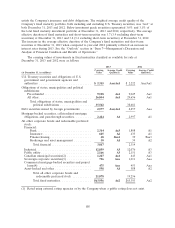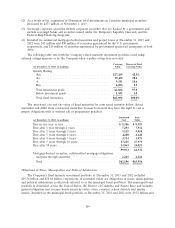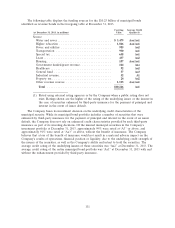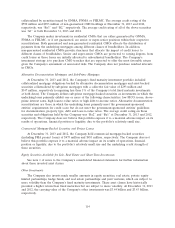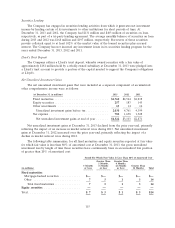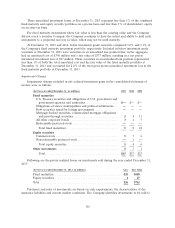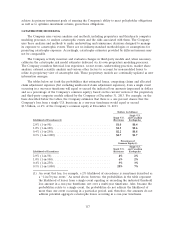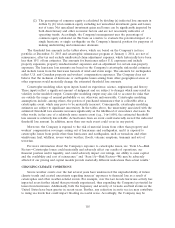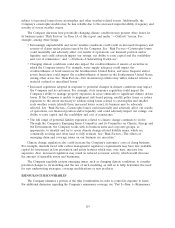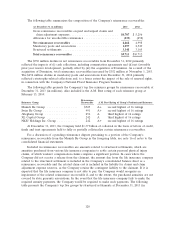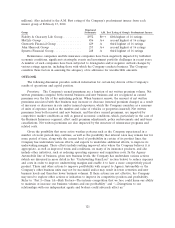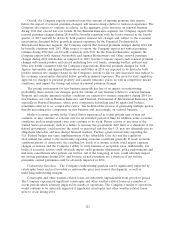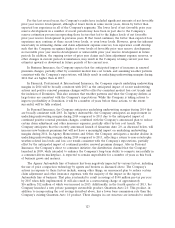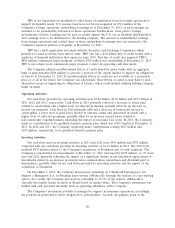Travelers 2013 Annual Report Download - page 128
Download and view the complete annual report
Please find page 128 of the 2013 Travelers annual report below. You can navigate through the pages in the report by either clicking on the pages listed below, or by using the keyword search tool below to find specific information within the annual report.(2) The percentage of common equity is calculated by dividing (a) indicated loss amounts in
dollars by (b) total common equity excluding net unrealized investment gains and losses,
net of taxes. Net unrealized investment gains and losses can be significantly impacted by
both discretionary and other economic factors and are not necessarily indicative of
operating trends. Accordingly, the Company’s management uses the percentage of
common equity calculated on this basis as a metric to evaluate the potential impact of a
single hurricane or single earthquake on the Company’s financial position for purposes of
making underwriting and reinsurance decisions.
The threshold loss amounts in the tables above, which are based on the Company’s in-force
portfolio at December 31, 2013 and catastrophic reinsurance program at January 1, 2014, are net of
reinsurance, after-tax and exclude unallocated claim adjustment expenses, which historically have been
less than 10% of loss estimates. The amounts for hurricanes reflect U.S. exposures and include
property exposures, property residual market exposures and an adjustment for certain non-property
exposures. The hurricane loss amounts are based on the Company’s catastrophe risk model estimates
and include losses from the hurricane hazards of wind and storm surge. The amounts for earthquakes
reflect U.S. and Canadian property and workers’ compensation exposures. The Company does not
believe that the inclusion of hurricane or earthquake losses arising from other geographical areas or
other exposures would materially change the estimated threshold loss amounts.
Catastrophe modeling relies upon inputs based on experience, science, engineering and history.
These inputs reflect a significant amount of judgment and are subject to changes which may result in
volatility in the modeled output. Catastrophe modeling output may also fail to account for risks that
are outside the range of normal probability or are otherwise unforeseeable. Catastrophe modeling
assumptions include, among others, the portion of purchased reinsurance that is collectible after a
catastrophic event, which may prove to be materially incorrect. Consequently, catastrophe modeling
estimates are subject to significant uncertainty. In the tables above, the uncertainty associated with the
estimated threshold loss amounts increases significantly as the likelihood of exceedance decreases. In
other words, in the case of a relatively more remote event (e.g., 1-in-1,000), the estimated threshold
loss amount is relatively less reliable. Actual losses from an event could materially exceed the indicated
threshold loss amount. In addition, more than one such event could occur in any period.
Moreover, the Company is exposed to the risk of material losses from other than property and
workers’ compensation coverages arising out of hurricanes and earthquakes, and it is exposed to
catastrophe losses from perils other than hurricanes and earthquakes, such as tornadoes and other
windstorms, hail, wildfires, severe winter weather, floods, volcanic eruptions, tsunamis and acts of
terrorism.
For more information about the Company’s exposure to catastrophe losses, see ‘‘Item 1A—Risk
Factors—Catastrophe losses could materially and adversely affect our results of operations, our
financial position and/or liquidity, and could adversely impact our ratings, our ability to raise capital
and the availability and cost of reinsurance’’ and ‘‘Item 1A—Risk Factors—We may be adversely
affected if our pricing and capital models provide materially different indications than actual results.’’
CHANGING CLIMATE CONDITIONS
Severe weather events over the last several years have underscored the unpredictability of future
climate trends and created uncertainty regarding insurers’ exposures to financial loss as a result of
catastrophes and other weather-related events. For example, over the last decade hurricane activity has
impacted areas further inland than previously experienced, thus expanding the Company’s potential for
losses from hurricanes. Additionally, both the frequency and severity of tornado and hail storms in the
United States have been greater in recent years. Further, any reduction in arctic sea ice may contribute
to rising sea levels that could impact flooding in coastal areas. Accordingly, the Company may be
118


